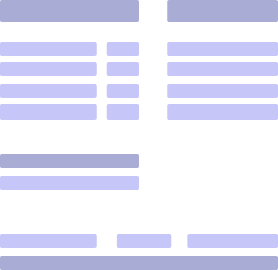Invoice Payment Terms: A Complete Guide for Businesses

February 28, 2023
Invoice payment terms are contractually determined details that specify how a payer will compensate the payee for their goods or services. Also referred to as payment terms or invoice terms, they outline the amount to be paid, the payment method, and the due date.
Properly defining business payment terms on an invoice is critical for professionals who want to optimize cash flow management, enhance the financial health of their operations, and ensure operational stability. We’ll teach you how to achieve that and show you some examples of payment terms to help you create perfect invoices!
Key Takeaways
- Invoice payment terms are sets of conditions a payer should follow when compensating a payee for provided goods or services.
- Well-written payment terms with a clear invoice due date, amount, accepted payment methods, and other critical details prevent misunderstanding and protect your rights as a seller.
- You should choose the preferred payment method depending on your industry, circumstances, and client relationships (e.g., payment terms for freelancers and large businesses will differ significantly).
- Introducing early discounts encourages faster payments, while having late fees increases the chances you get paid before the due date.
What are Invoice Payment Terms?
Invoice payment terms or payment terms contain essential information needed in any transaction, such as the payment due date, specific payment terms, and all other contractual agreements between the buyer and the seller.
Payment terms may be used to hold customers accountable for their purchases by ensuring they provide the payment equivalent to their order. At the same time, the terms give your accounts payable department an idea of when to follow-up customers for their payments.
According to the Small Business Administration, freelancers can benefit as well from using invoice payment terms, particularly when they supplement them with a legally binding contract. The contract must contain an agreement on the goods offered and accepted between all involved parties in exchange for something of value, such as cash or services.
How to Use Invoice Payment Terms
You should use invoice payment terms to clearly define how and when a customer or client should pay for goods or services. Make sure to use precise, easy-to-understand, industry-standard terminology to prevent misunderstandings or payment errors.
When setting the terms up, make sure to specify invoice payment deadlines. You can include “Due Upon Receipt” if you want an immediate payment or net terms like “Net 30” or “Net 60” to indicate the payment is due within 30 or 60 days, respectively.
Additionally, you can mention any potential discounts for early payments or late fees. You should also list the accepted payment methods (e.g., bank transfer or credit card).
How to Communicate Invoice Payment Terms
The best way to communicate invoice payment terms is with a precisely written invoice or contract. However, you should always make sure that the payee understands the terms, especially if you can communicate them in advance before signing the contract or sending an official invoice.
To ensure there are no misunderstandings, you can ask the invoice recipient if they need additional clarification. You can communicate additional details via email, messages, or by having a meeting.
Key Components of Invoice Payment Terms
Some of the key components of invoice payment terms include:
- Invoice date. Every invoice has a date that states when it was issued.
- Currency. Specifying the currency in your invoice payment term is especially essential if you are selling your services or shipping goods internationally.
- Preferred payment methods. This information enumerates all the different types of payments that your business accepts. Some of the most common payment methods include bank transfer, credit cards, digital wallets, and online transfer.
- Total amount owed. Provide the total amount due that the customer must pay in exchange for the goods or services they ordered.
- Payment due date. The payment due date specifies the latest date when a payment can be made or sent by a customer before the seller marks it overdue.
- Other payment conditions (if any). This will include any additional fees or penalties if payments are sent past the specified due date.
Common Invoice Payment Terms and Abbreviations

Here are some examples of invoice payment terms abbreviations that typically appear in a billing or an invoice statement:
Abbreviation | Meaning |
|---|---|
This means that the customer is qualified for a 2% discount if they send payment within 10 days. Full payment is expected by the seller after 10 days, but the final due date for the payment is 30 days from invoice date. | |
21 MFI | The payment is due on the 21st of the month following the invoice date. |
CIA (cash in advance) | The customer fulfills the payment before the goods or services are shipped or received. CIA can usually be done through credit card payments or wire transfer. |
CND (Cash next delivery) | This detail appears when items are delivered regularly. It may be monthly or even weekly, and the customer must complete their payments before the next delivery is processed. |
COD (Cash on delivery) | The customer pays for the item or goods upon delivery in cash. |
Contra | This refers to a type of transaction where two businesses or companies agree to exchange services or goods that are of equal value. The payment is in the form of the goods exchanged. |
CWO (Cash with order) | Cash with order means the payment is made at the same time that the order is made. |
EOM (end of month) | The payment is due at the end of the month when the invoice is issued. |
PIA (payment in advance) | The customer must pay in full before the goods they ordered are delivered. |
Rebate | Also called a refund or pay back, rebates are sent to the buyer if they send payments in excess. |
Stage payments | It refers to a set of payments or installments agreed upon by both the seller and the customer that the latter must settle over a period of time. |
Accumulation discounts | These typically appear when a customer exceeds a specific number of items in their order, making them eligible for a discounted price. |
Payment Methods on an Invoice
Let’s explore the different payment methods on an invoice in more detail:
#1. Immediate Payment
Immediate payment is due upon receiving the invoice. This method is commonly used for small transactions, freelance work, and cash-on-delivery shipments.
One of the biggest benefits of this method for the payee is the minimized risk of late payments, which optimizes their cash flow. However, this isn’t always the preferred method for clients and customers, especially when it comes to large transactions.
#2. Prepayment
Prepayment, or sending payment in advance, means paying before receiving goods or services. This is common in industries that require scheduling services or purchasing specialized goods or materials ahead of time.
Prepayment ensures that the client will commit to the deal while minimizing financial risk on the payee. However, many clients will hesitate to pay in advance, which is why service providers can offer discounts and assurances through contracts and refund policies.
#3. 50% Upfront
A 50% upfront payment requires the invoice recipient to pay half of the sum upfront and the other half as agreed upon and established in the contract. This method is also known as “down payment,” and its main benefit is reduced risk on both sides of the contract.
Goods or service providers receive an upfront investment to improve their financial security while committing to delivering the project and giving flexibility to customers. While there is a reduced risk of non-payment, it’s crucial to clearly define how the remaining 50% will be paid in the contract.
#4. Installments
Installments represent portions of the sum paid over time in a scheduled manner. This is a common payment method for large sums, like with expensive products and services or considerable projects.
Payments are given in regular intervals, such as monthly or quarterly. They can be with or without interest, offering a flexible payment method attractive to many customers.
#5. Lines of Credit
Lines of credit allow customers to purchase goods or services on credit and pay later. A credit limit depends on the agreement, and the payment is made after a specified period.
This method is common in B2B transactions that involve large sums. It’s typically reserved for trusted partners, as there’s always the risk of missed or delayed payments from the client.
#6. Subscriptions or Retainers
Subscriptions and retainers represent regular and fixed payments for ongoing services or access to products. This is a common payment method in the SaaS (software-as-a-service) industry, online memberships (e.g., Netflix or Amazon Prime), consulting services, etc.
Payments are typically processed automatically, giving payees predictable and recurring revenue and improving their financial stability.
5 Major Benefits of Detailed Invoice Payment Terms

In the section below, we’ll talk about some of the benefits of having detailed invoice payment terms.
#1. Less Ambiguity
Payment discrepancies are not always the fault of the customers. For example, an invoice that contains ambiguous and incomplete information could cause miscommunication between the seller and the customer.
For instance, the invoice may not have clearly stated the payment due date or the accepted payment methods, or it may have inaccurately described the payment terms agreed upon by both parties.
So, always double-check that you enumerate complete and accurate information in all your invoice terms at all times.
#2. Get Paid Faster
Whether you accept installment or subscription-based payments, going for the shortest possible payment term is always ideal.
Giving customers too much leeway regarding their payment obligations often leads to higher instances of late payments. Whereas, if you set the payment deadline to seven or 15 days from the invoice date, you have a higher chance of receiving full payment earlier.
It is also worth noting that the longer the payment is due, the more customers tend to forget or disregard their financial obligations to your business.
#3. Better Cash Flow Control
Complete invoice payment terms secure consistent and improved cash flow control. When you describe in full detail the total amount due, when the payments must be made, and on what terms, you reduce any room for error for your customers.
All that’s needed is for the buyer or customer to fulfill the expected payment based on the terms and methods stated in the invoice. By consistently issuing detailed invoice terms, you establish a concrete system that secures your business against potential losses and stalled revenue.
#4. Seller Protection
It is unfortunate that scams are rampant these days, and businesses, regardless of size, are not exempt from being targeted by fraud. You need a form of leverage to protect your business in the event of any disputes.
For instance, a customer with an overdue payment might argue that you did not specify when the payment is due. However, if you have clearly stated a deadline in your payment terms, the claim will likely backfire against the customer, clearing you from any potential liabilities.
#5. Follow-up Payments
It is easier to send follow-up notices to customers, especially if the payment deadline is near. At the same time, you can use your invoice payment term to track any habitual late payers among your customers.
Consequently, you can set up an email or push notification in advance to remind customers to send their payments and reiterate accepted payment methods to help ease the process for them.
7 Tips and Best Practices for Invoice Payment Terms

Now that you are familiar with invoice payment terms and their benefits, let’s give you some tips on how to prepare them!
#1. Set Concrete Deadlines
Specify the deadlines for customer payments. It is not enough to state that payments are due “30 days from invoice date,” as this could easily be misinterpreted.
Supplement the information with a concrete deadline. Ensure that this key piece of information is indicated clearly and legibly in the invoice.
#2. Introduce Late Fees
One of the main reasons why habitual late payers do not seem to care that they have overdue payments is the lack of clear consequences for their delinquent accounts.
Introducing late fees sets a clear limitation that customers must acknowledge to reduce instances of overdue payments. Most customers would not want to shoulder the additional costs that result from sending payments past the deadline.
#3. Use Online Invoice Generators
If you are handling multiple orders and making invoices on your own, it is inevitable to commit a few errors in your invoice terms.
That’s where online invoice generators come in! They automate the invoicing process for you. Generators are easy to use, don’t take as much time as programs such as Word or Excel, and they’ll provide you with flawless invoices!
#4. Allow Multiple Payment Options
Don’t limit your customer’s options to a single payment method. Instead, offer alternatives to highlight customer convenience.
Customers appreciate it when sellers offer more than one payment option, as this enables them to settle their payments faster and more easily.
#5. Provide a Discount For Early Payment
If there are consequences for overdue payments, then it is also fitting to offer rewards in the form of discounts for customers who can settle their payments early.
Rewarding customers for early payments reinforces this type of behavior from your customers. Discounted prices are also an effective way to build rapport with your customers and entice them to explore your services and products.
#6. Discuss Payment Terms
Discussing the payment terms before sending the invoice is more plausible for consulting and legal services. That is because some arrangements and conditions need to be thoroughly explained to the client first.
Explain your payment expectations from the clients. Provide additional information on their payment options, along with the coverage of the services that they are paying for.
#7. Bill Your Goods and Services to the Correct Individual
Your invoice must be billed to the person who pays for the goods or services. Doing so makes it easier to follow up on payments in the future.
It will also reduce misunderstandings on the part of the customer. Moreover, it prevents scammers from attempting to use the personal information of unsuspecting victims and keeps delinquent customers from evading their financial obligations.
How to Make a Perfect Invoice Like a Professional
The best way to make a perfect invoice is by using an online invoice generator. At Paystub.org, we offer a professional yet user-friendly software solution that you can use to generate your invoice in minutes.
Here’s a step-by-step guide on how to make an invoice quickly and like a professional:
#1. Choose the Right Document

Start by clicking on the “Invoice” button on the main page of our website. Note that you can just as easily make a paystub, Form W-2, or Form 1099, as well.
#2. Choose a Template

Select a template that suits your needs. We offer several different templates, each with a unique look and format to help match the style of your business. For added customizability, most templates allow you to choose between three different colors.
#3. Input the Details

After selecting the template, you should fill out the form by adding all the necessary information in the required fields. On top of all the relevant details about you and your client, you can also upload your logo, add or remove items, and leave notes.
#4. Review the Document

Once you finish creating your invoice, you’ll get a preview of what the final product will look like. This allows you to double-check the information you entered for errors and see whether you need to add or remove something.
#5. Download Your Invoice

Finally, once you confirm the invoice is up to your standards, you can accept our Terms of Use and Privacy Policy and go to the checkout to download your document.
Final Thoughts
Well-thought-out invoice payment terms allow businesses to optimize their cash flow and maintain financial health while building strong client relationships. The exact payment terms for the services or goods you sell should depend on your industry and specific circumstances.
Depending on the client, you may opt for immediate payment and maximum security, create an invoice payment schedule that offers flexibility, or offer a credit line to trusted partners. Regardless of your invoice payment policy, you can use our invoice generator to create documents in minutes and with no effort!
Invoice Payment Terms FAQ
#1. What are reasonable payment terms?
Reasonable payment terms are those that suit both the payer and the payee. They depend on the industry and specific circumstances. For instance, immediate payments are common for small projects and freelance work, while credit lines are typical in large-scale B2B transactions.
#2. How do I structure payment terms for international clients?
To structure invoice payment terms for international clients, you should consider regional payment differences and bank processing times. Use one of the globally accepted payment methods that suit both parties (e.g., wire transfers or credit cards) and consider prepayment or down payment to minimize the risks.
#3. What happens if a customer doesn't pay on time?
If a customer doesn’t pay on time, you should first send a polite reminder. Some delays are due to processing issues or simple oversights. If a reminder doesn’t work, you can escalate the situation by sending a formal notice. If that doesn’t work either, you can seek legal action.
#4. Can I charge a late fee for overdue payments?
Yes, you can charge a late fee for overdue payments, but only if they are established in the invoice or contract payment terms. Late payment fees can be fixed or calculated per month. Make sure to follow relevant laws and clearly communicate these fees in advance to ensure legal compliance.
#5. How do I handle clients who don't follow payment terms?
If clients don’t follow payment terms, you can warn them with formal notices before resorting to collection agencies or legal action. If you want to continue working with them in the future, consider tightening the payment terms to include prepayment or deposits and incorporate fees for not following payment terms.


